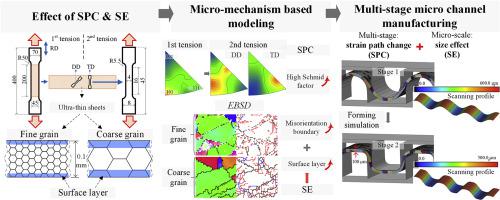International Journal of Machine Tools and Manufacture ( IF 14.0 ) Pub Date : 2021-02-19 , DOI: 10.1016/j.ijmachtools.2021.103713 Rui Zhang , Zhutian Xu , Linfa Peng , Xinmin Lai , M.W. Fu

|
Multi-stage plastic deformation of metallic sheets for fabrication of complex micro structures with high aspect ratio features in different industrial clusters has been prevailing due to product miniaturization and integrated manufacturing. Owning to the varying strain path and the miniaturized scale of work pieces, both the strain path change (SPC) and size effect (SE) significantly affect the micro-scale deformation behaviors. To have a scientific insight and understanding of the influences of SPC and SE, two-stage tensile tests were conducted using the 0.1 mm thick SS 316L sheets with different grain sizes and EBSD was employed to characterize the microstructure evolutions. The results showed that the yield stress and elongation rate in the second tensile stage were decreased with the increase of pre-strain and the intersection angle between two tensile directions, while the hardening rate was found to be solely dependent on pre-strain. Changing the tensile direction in the second stage reversed the orientation distribution preference and raises the percentage of high Schmid factors, resulting in lowering the yield stress and hardening rate. On the other hand, more intra-granular mismatching boundaries accumulate in the coarsened grains, which impedes the dislocation movement and increases the deformation resistance. These two confronted mechanisms of SPC and SE interactively influence the deformation behaviors. A constitutive model for describing the flow stress affected by SPC and SE was established based on the micro-mechanism, which provided a basis to support the multi-stage microforming.
中文翻译:

考虑应变路径变化和晶粒尺寸效应的两阶段拉伸变形超薄钢板建模及其在多阶段微成形中的应用
由于产品的小型化和集成制造,用于在不同工业集群中制造具有高长宽比特征的复杂微结构的金属板的多阶段塑性变形已成为主流。由于应变路径的变化和工件的微型化,应变路径的变化(SPC)和尺寸效应(SE)都会显着影响微观尺度的变形行为。为了科学地了解和理解SPC和SE的影响,我们使用了0.1毫米厚的具有不同晶粒尺寸的SS 316L薄板进行了两阶段拉伸试验,并采用EBSD表征了组织的演变。结果表明,随着预应变和两个拉伸方向相交角的增加,第二拉伸阶段的屈服应力和伸长率降低,而硬化速率仅取决于预应变。在第二阶段中更改拉伸方向会逆转方向分布的偏好,并提高高Schmid因子的百分比,从而降低屈服应力和硬化速率。另一方面,在粗化晶粒中积累了更多的晶粒内失配边界,这阻碍了位错运动并增加了抗变形性。SPC和SE的这两个面对的机制相互作用地影响变形行为。用于描述受应力影响的流应力的本构模型 而发现硬化速率仅取决于预应变。在第二阶段中更改拉伸方向会逆转方向分布的偏好,并提高高Schmid因子的百分比,从而降低屈服应力和硬化速率。另一方面,在粗化晶粒中积累了更多的晶粒内失配边界,这阻碍了位错运动并增加了抗变形性。SPC和SE的这两个面对的机制相互作用地影响变形行为。本构模型描述流场受应力影响。而发现硬化速率仅取决于预应变。在第二阶段中更改拉伸方向会逆转方向分布的偏好,并提高高Schmid因子的百分比,从而降低屈服应力和硬化速率。另一方面,在粗化晶粒中积累了更多的晶粒内失配边界,这阻碍了位错运动并增加了抗变形性。SPC和SE的这两个面对的机制相互作用地影响变形行为。本构模型描述流场受应力影响。从而降低了屈服应力和硬化速率。另一方面,在粗化晶粒中积累了更多的晶粒内失配边界,这阻碍了位错运动并增加了抗变形性。SPC和SE的这两个面对的机制相互作用地影响变形行为。用于描述受应力影响的流应力的本构模型 从而降低了屈服应力和硬化速率。另一方面,在粗化晶粒中积累了更多的晶粒内失配边界,这阻碍了位错运动并增加了抗变形性。SPC和SE的这两个面对的机制相互作用地影响变形行为。用于描述受应力影响的流应力的本构模型基于微观机制建立了SPC和SE,为支持多阶段微成形提供了基础。


























 京公网安备 11010802027423号
京公网安备 11010802027423号